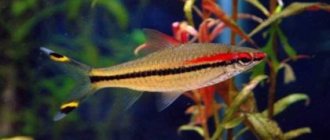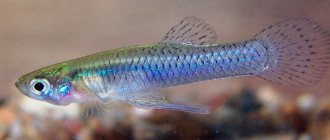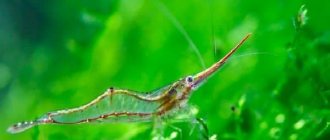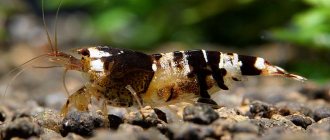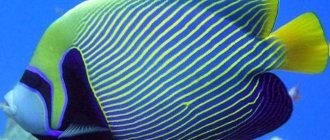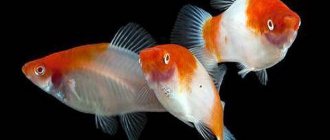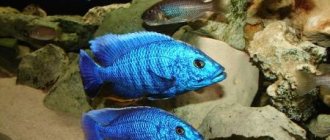5
(1)
Glass perch is an aquarium fish that gets its name due to its unique appearance. The skin and tissues of a perch are completely transparent, and through them you can see the skeleton and internal organs of the animal.
The fish has a transparent natural shape, but many farm breeders artificially color the fish by injecting luminescent dye with a needle under the skin. Typically, after injection, the dyed glassfish will die within the next few months. In this regard, some European countries have decided to abandon the sale of colored fish, so as not to harm pets, but this service remains popular.
Description
The maximum size of the fish is 8 cm. A distinctive feature is the transparency of the body. Due to the myth that glass perch are only found in salt water, they are not popular among hobbyists and beginners.
Appearance
The glass fish has a tall, flat body. The perch is translucent, the spine and internal organs are visible. The head and belly are silvery. Artificially colored varieties have a clear base and back in orange, blue, green and other bright colors. There are two-colored perches with the back and belly of different colors. The fins are pointed. The lower fin of the perch, as if in a mirror image, follows the outline of the dorsal one. The tail is forked.
Behavior
Glass fish are peaceful and playful. In nature they live in groups. When kept alone, they show shyness and depression.
Lifespan
Colorless perches live on average 3–4 years, colored ones – 2–6 months.
How to distinguish male and female
The gender of an individual can be determined by the shape of the air bubble visible through the transparent skin of the fish:
- in males it is slightly pointed,
- in females it is more rounded.
In addition, boys have brighter colors, as much as possible for a transparent pet. The shade of the scales ranges from yellow-green to yellow-orange.
There are 5 transverse stripes on the side, which are formed by black spots.
Girls are more modestly colored and mostly have a silver-steel tint to their scales.
In nature, fish grow up to 8 cm in length, but in an aquarium they reach only 5 cm.
Content
Glassfish have gained a reputation for being fastidious aquarium dwellers. However, uncolored forms have strong immunity, do not require a large aquarium and live in different water parameters. Found in fresh and salt water. Suitable for beginners.
In a freshwater aquarium
Perch that was previously kept in salt water can be acclimatized to fresh water. Use a quarantine vessel with salted water, changing 10–15% of the liquid daily to fresh water. After two weeks, the glass fish gently adapts to new conditions.
In salted water
Season the water with sea salt. Table salt is not suitable for its composition. To obtain lightly salted water, add 1-2 teaspoons of salt for each liter. Measure the specific gravity of the water with a hydrometer; values of 1005–1010 are suitable. First dissolve the substance in water, then pour it into the container. Fish brought from salt water do not require long adaptation in a salted water aquarium.
Aquarium
Keep the transparent water inhabitants in a flock of 6 or more individuals. For a small group of perches in a species aquarium, a volume of 80 liters is suitable. A comfortable aquarium volume for a larger flock starts from 110 liters.
View this post on Instagram
Glass perch is very popular among aquarists due to its unusual appearance and ease of maintenance. It is better to keep such fish in small schools of 8-12 individuals. #perch #glass perch #aquarium #aquarium science #fish #beautifulfish #transparentfish #aquarium #aquafish #fish #chandaranga
A post shared by Evgeniy Aquariumist (@aqua.fish.club) on Jan 16, 2021 at 11:18pm PST
To decorate your aquarium use:
- driftwood;
- caves;
- stones;
- grottos.
Decorative elements should serve as shelters for perches. Avoid placing sharp decorations to avoid injuring the fish.
Water parameters
Keep perches in clean water with the following parameters:
- water temperature 20–26 degrees;
- hardness 8–20 dGh;
- acidity 6.5–8.
Change the water by 25% every 7-10 days. Check the liquid for nitrates, ammonia and other harmful compounds.
Plants
Create shelters and shaded areas with floating and ground-rooted plants:
- duckweed;
- Riccia floating;
- cryptocorynes;
- Java moss;
- Thai fern.
Place tall greenery in the back and small ground cover plants in the foreground. If the perch is kept in brackish water, make sure that the plant is suitable for this environment. Choose unpretentious plants that do not require intense light.
Priming
Fine, smooth soil in dark shades is suitable for glass fish. Clean the soil weekly, combining a siphon with a fluid change. Boil the stones thoroughly if they were collected outdoors. Be careful with colored primer; dyes are dangerous for fish.
Equipment
To keep a glass perch, it is enough to place:
- Filter. For a medium-sized aquarium, an internal filter is suitable. Make sure that the device does not create a strong water pressure. Perches live in bodies of water with weak currents.
- Compressor. The reservoir must be saturated with oxygen to make the glass fish comfortable. Additional aeration is provided by plants.
- Heater. Placed if necessary.
- Thermometer. A glass immersion thermometer shows the temperature more accurately than an external device.
Lighting
Create subdued lighting. Too bright light makes the fish nervous. To prevent water blooms, place the aquarium away from sunlight.
Feeding
The transparent inhabitants of the aquarium are omnivores, but sometimes feeding dry food requires gradual training of the fish. Before purchasing, check what specific fish are fed. Make a diet of the following foods:
- dry branded food;
- Artemia;
- gammarus;
- bloodworm;
- Daphnia;
- cucumbers;
- zucchini;
- lettuce leaves;
- coretras.
Feed Indian glassfish 1-2 times a day in small portions that are eaten within 5 minutes. Do not overuse dry food; the fish menu should be varied. Treat live food with a solution of methylene blue or metronidazole before serving to avoid introducing parasites into the aquarium. To prevent food particles from flying around the aquarium, use a feeder.
The best neighbors for a glass fish
Having created better living conditions, you need to take care of the neighbors of peace-loving fish. Since Indian perches are very shy, you need to carefully consider which other inhabitants of the aquarium can be added to them. The main thing is to exclude aggressive and predatory fish. The best neighbors are:
- rasboras;
- Nannakars;
- Denmark;
- battles;
- tetras;
- bee gobies;
- guppy;
- mollies.
They have excellent compatibility with glass perch. All these fish occupy their specific place in the aquarium, distributed throughout the entire water column. In addition, they will not offend the glass perch, forcing the latter to hide all the time. And they won’t have any disputes on the issue of nutrition.
Goby gets along well with perch
Compatibility
The peaceful temperament ensures the compatibility of glass perches with different types of aquarium fish. Large and aggressive neighbors will injure and even eat glass fish. Examples of incompatible species:
- cichlids;
- piranha;
- goldfish;
- cockerels;
- gourami.
When choosing neighbors, take into account the similarity of temperaments and water parameters.
Neighbors in a freshwater aquarium
Finding neighbors for a freshwater aquarium is much easier. The following types are suitable:
- rasboras;
- zebrafish;
- guppy;
- platies;
- battles;
- tetras;
- neons;
- cardinals;
- iris.
View this post on Instagram
Our neonfish and perches are vigorous and cheerful, what do we wish for you too? ?Aquariums? Terrariums ?Professional service #aquarium #aquarium science #aquariumfish #aquariumhomes #fish #underwaterworld #aquariumdesign #aquarium maintenance #aquarium cleaning #aquariumorder #aquariumlife #aquariuminterior #aquariumdesign #Moscow #aquarium maintenance #nature #super #instagramweeks #likes # beauty #follow your dreams #like me #follow mutually #neonfish #aquascape #neon #glassperch #fishincube
A post shared by Fishincube (@fishincube) on Oct 11, 2021 at 9:56pm PDT
Neighbors in a salty aquarium
Choose peaceful fish that can tolerate low salt concentrations:
- spotted goby;
- mollies;
- guppy;
- splash fish;
- some iris (blue-eyed neon, Sulawesi);
- bee goby.
Habitat
Inhabits stagnant bodies of brackish and fresh water in India, Burma, Pakistan, Malaysia, Bangladesh, Thailand, Nepal and Cambodia.
Reproduction
Breeding glass perch is not difficult, but caring for the fry is troublesome. Perch breed all year round in the aquarium, but the eggs are eaten. To save offspring, prepare a spawning tank.
Sex differences
Sex your bass when they are ready to breed. Then the gender differences become more pronounced. You can distinguish a male from a female by the following characteristics:
- the presence of a yellow tint in the color;
- pointed air bubble;
- blue edging on fins.
Spawning
Readiness for reproduction comes at 6 months. Stimulate spawning by changing the water to fresh water and increasing the temperature by 2-3 degrees. The water in the spawning tank should be soft, and the temperature should be around 28 degrees. Prepare broad-leaved plants, such as ferns, to house the eggs. Feed the male and female meat food. The female lays up to 200 eggs at a time. After the glass perches have dispersed their eggs, remove the spawners from the container. To protect the eggs from fungi, add a couple of drops of methylene blue to the tank.
Offspring
The fry appear within 24 hours and become independent within 3–4 days.
Start feeding the fry:
- ciliates;
- liquid feed;
- rotifer;
- chopped egg yolk;
- Artemia.
Feed food 3-4 times daily. Dispose of any uneaten remains immediately. Make sure all the fry are well fed, but do not overfeed them. Provide young animals with high-quality water with stable parameters.
Nutrition
When it comes to food, perch is also unpretentious. He may well consume artificial food, but to preserve the reproductive function, it is better to use live or at least frozen food. This could be a bloodworm, cyclops, daphnia, coretra or tubifex. Feeding frequency: at least 3 times a week in small portions throughout the day. The fry should be fed Diaptomus nauplii for the first few days after birth.
Diseases
Unpainted glassfish rarely have health problems. Multi-colored Changa-Ranga have weak immunity; in poor conditions they easily get sick:
- Oodiniumosis (“gold dust”). The disease is accompanied by itching in the fish and the appearance of a yellowish coating on the body. Treat the disease with fever and copper sulfate.
- Ichthyophthyriasis (“semolina”). White dots appear on the body of the perch. Treated with medications from the pet store.
- Dropsy. The belly of the perch swells, the scales bristle. To get rid of dropsy, provide glass fish with a calm environment, gradually increase the quality of the water, and feed your pets food mixed with antibiotics.
- Fin rot. Bacteria attack the tail and fins, ultimately leading to their complete disappearance and death of the fish. Treated with malachite greens.
- Tuberculosis. A long stay in poor quality water or the appearance of infected fish in a tank stimulates this terrible disease. Rarely treatable.
Neglected diseases and sudden changes in water parameters lead to death. Perches can suffer from a lack of oxygen (hypoxia), ammonia and chlorine poisoning.
Reviews
Some aquarists have been disappointed to learn that colored specimens do not live long and quickly lose color. Fans of perches note that the pets look unusual in the aquarium and are easy to breed, as evidenced by numerous photos and videos.
Photo
Adviсe
- Glass changa-ranga look more impressive with colorful neighbors like zebrafish and rasbora cuneiformis. These views create contrast.
- Do not use a carbon dioxide generator for plants in brackish water. This can upset the biological balance.
- If you want to place incompatible species in one tank, get a spacious aquarium and place a lot of hiding places in it. The likelihood that some neighbors will harm others is reduced.
- When buying glass fish, inspect them. If the fish are depressed and damaged, do not purchase these perches. Avoid buying painted fish; they will not decorate your aquarium for long. There are colorful species that are healthy and long-lived, such as rasboras and zebrafish.
Artificial coloring of glassfish is inhumane, so the sale of colored specimens is prohibited in Europe. To introduce paint, the fish's skin is pierced with a needle. Often on sale are GloFish - thornets, zebrafish and barbs of rich colors. The species was created by genetic modification. There are many conflicting opinions about such individuals.
Previous
FishAttractive Blue Dempsey Cichlid
Next
FishDoctor Garra Rufa Fish
Buying a pet
When purchasing this fish, it is important to remember that its body is completely transparent. The fact is that you can often find glassy colored perch on sale, but this color is not natural. In Southeast Asia, there are entire farms where fish are dyed by injecting luminescent dyes into their muscles with a large needle. After this painful procedure, perches do not live longer than two months, unlike their unpainted counterparts, who feel great for three to four years.
Of course, a painted perch attracts more attention, it is brighter and looks much more impressive, but the price of all this is too high. Moreover, luminescent paint quickly becomes pale and inexpressive, losing its attractiveness.
And if in Russia they still sell bright changa-ranga with all their might, in Europe they have already banned the sale of colored fish.
When purchasing Indian perch, you should pay attention to the mobility of the fish, the integrity of its fins, and the absence of foreign growths and damage to the skin. This is the only way to buy a pet that will delight its owner with a healthy appearance for many years.
When buying a perch there are a number of nuances
